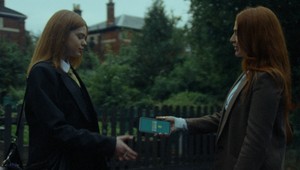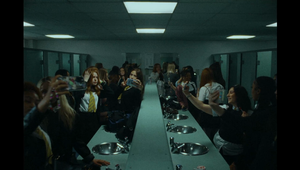
5 Minutes With… Carol Lam

Carol Lam’s career is like a perfectly formed circle. She first dipped her toe into the advertising industry several years ago with an internship at Saatchi & Saatchi China and now, after stints at JWT, McCann and TBWA, she’s back. Only this time she’s the Chief Creative Officer and Managing Partner. But she wasn’t always destined for advertising – Carol originally studied journalism and even today the values she learned as a student and that insatiable journo’s curiosity find their way into her work. LBB’s Laura Swinton caught up with her to find out more.
LBB> You've been at Saatchi & Saatchi China for about a year and a half now - what attracted you to it, and what makes the agency unique in the Asia Pacific region?
CL> When Saatchi & Saatchi China approached me, they gave me a succinct brief: ‘Help us reboot the creative engine of our South China operation in three years, and show people in this part of the world what Saatchi & Saatchi stands for.’
I like the idea. Saatchi & Saatchi has always been a brand of legacy to me. It deserves a better standing in China. Better still, some of the finest brains I used to work closely with in previous agencies are with Saatchi & Saatchi now. Great chemistry leads to great work and great fun. As Kevin Roberts put it ‘Saatchi & Saatchi. Paarty & Paarty.’ So here I am.
What makes us unique is our belief in excellence instead of size – though we are never small in size. We don’t have bulky organisation structure across all levels up to senior management. And we don’t have complicated matrix and silos to manage within the organisation. The leadership team within China and across the region stands tight together for a pure common goal – make One Saatchi & Saatchi the strongest and the best.
This makes us swift and agile in responding to the changing needs of our clients and the world because our energy can be focused on winning the champions out there.
LBB> As I understand it you actually did an internship at Saatchi & Saatchi Hong Kong... What was it like having had that experience at the start of your career to come back at such a senior level?
CL> Time changes. Media changes. The mind-sets of people change. And so how we do advertising changes. The only thing that remains unchanged is the change itself. I always like the quote ‘it’s ok to look back at the past. Just don’t stare.’
On that note, I don’t feel particularly ‘sentimental’ on my returning to Saatchi & Saatchi despite my admiration for the company at all times. Like every chapter in my career, returning to my first agency signals a new chapter ahead - a totally new ball game, new chemistry of talents, new motivations, new challenges and opportunities to reinvent and make great. You are just as good as your next creation. It’s got nothing to do with your seniority.
That said, the fact that I started my career as a Saatchi & Saatchi intern does project some ‘halo effect’ to the young folks in our agency. One day one of our interns made a stupid mistake and screwed up. She cried. I went and gave a pat on her shoulders ‘Don’t cry. I was as useless as you when I was an intern here.’ She was motivated. It’s not a bad thing if I can be their role model at some point of their life.
LBB> Your original degree was in journalism - why did advertising tempt you over?
CL> It feels like only yesterday that I attended the Journalism 101 course outlining the purpose of journalism and the respective media ethics. You can’t imagine how much impact that can have on a 17-year-old – how it changed her values and informed how she looked at the world.
Journalism is about being the watchdog of the society. It emphasises truthfulness, accuracy, objectivity, impartiality, fairness, and public accountability. All are important principles and respectful values.
A responsible journalist cannot and should not ‘create’ stories. The problem is that I like to create stories. Advertising provides me a better platform to create stories based on human truths that touch people’s heart and reshape people’s perception. We also demand truthfulness and accuracy. But we are allowed to be emotional and sometimes sensational. As a profession, advertising suits me better indeed. It’s more fun and I can be more carefree.
LBB> As a creative, how have you found that your journalistic skills and training have helped you?
CL> My journalistic training taught me how to dig deep on one subject and identify the best perspective to tell a story. Clues (or what we call ‘inspiration’) are everywhere. Every dot connects. It takes an observant eye and sensitive heart to dig it out. A fresh perspective and a profound idea is the key. The other way that journalistic training has influenced my creative career is caring about humanity. Apart from selling commodities, how can a brand make the world a better place to live? Our job is to help brands find their higher purpose and inspire people with the good human values to create a better world.
LBB> We've been really enjoying the work that we've been seeing out of Saatchi & Saatchi China recently. A lot of playful and responsive stuff - which projects have you particularly enjoyed?
CL> I particularly enjoyed CCTV ‘Care for the Elderly’ campaign, one of my favourite works produced at Saatchi & Saatchi. This was the first time China’s state-owned TV station appointed and paid an international 4As agency to create a public service ad. You can imagine the expectation and the sweaty process involved! So it’s particularly motivating that the work turned out to be so phenomenal in China. Half a billion shares online, tonnes of favourite comments keep coming in today, it has impacted over 170 million families in China. One guy who had not contacted his parents since he left home seven years ago was touched by our CCTV campaign. He made a call home and decided to visit his parents next fall. This is indeed the finest moment for creative people who believe in world-changing ideas.
LBB> We loved the recycled newspaper idea for Chinese New Year - and the execution looked really striking too. How did that project come about and what were your memories of it?
CL> I was so pleased to see our young talents in action for the making of the Instant Newspaper Recycler. I loved it when one of our young teams showed me the idea.

The original client brief was just a press ad to convey their corporate green message. We turned it into an engaging consumer experience and let the company walk the walk. It’s a brilliant twist. When we showed the idea to the client they loved it too, but they were concerned about the timing – we had only two weeks to catch the Chinese New Year buzz. We don’t take no for an answer. Two weeks is tight but not impossible. Thanks to the team’s effort magic happened in a fortnight – from production to event and PR planning to actual delivery, brilliantly done. The guy inside the box operating the ‘recycling’ process is our production manager. He insisted on being the one to witness the customers’ reaction to our idea. He got all wet and lost two pounds after three days of ‘action’ inside the box. It turned out to be very successful. Clients were happy. Customers were happy. We were happy. It’s indeed a testament of our motto ‘Nothing is Impossible’.
LBB> You've worked at some pretty major agencies across the region - from what you've seen and experienced, how is Chinese and Asian creativity evolving?
CL> Our world is getting complicated. Condensing complicated thoughts into one single powerful idea is still essential, but no longer sufficient to win the war. Victory belongs to those who can manifest the ideas into a compelling brand experience that transforms the relationship between the brand and its customers.
Good brands project their brand purpose by what they say. Great brands go beyond and gain loyalty by how they behave. Identifying the highest possible order of benefits of a brand to people – and delivering them by walking the talk – is the holy grail of marketing and advertising. This applies to China as well.
LBB> When it comes to new talent is advertising seen as an attractive career in China? And what are the keys to nurturing the next generation of creatives?
CL> I wish they would consider advertising an attractive and preferred career, but the fact is that talented young people (I mean the truly talented ones) have many other choices. As technology arises, there are more platforms than ever for them to pursue their creative dreams. Often the young creatives join an ad agency for a year or two, then change their course and head out on their own into design, apps, game-making, e-publishing and even building their own Taobao (e-commerce) business.
For the new generation, passion is nothing without freedom. Individuality is more attractive than organisation. On one hand I feel happy for them. Young people should explore as many options as possible before they settle for any one thing. After all, the creative industry is an ecosystem of collaboration. On the other hand I feel advertising agencies should rethink their approach to attracting and retaining young blood. The ‘glamour halo’ of the Mad Man era is long gone. I think the new ‘glamour’ for the young generation comes from whether the agency is able to ‘put power in the hands of the youths’. And, well, that becomes a question of philosophy.
LBB> Who are your creative heroes and why?
CL> Hayao Miyazaki. The man behind the animated films ‘Nausicaa of the Valley of the Wind’, ‘Castle in the Sky’, ‘My Neighbor Totoro’, ‘Princess Mononoke’, ‘Spirited Away’, ‘Howl’s Moving Castle’, ‘The Wind Rises’…Check out his films and you’ll know why.
His work gives me a world full of imagination and inspiration on progressive themes that matter to the human race –environment, pacifism, feminism…
LBB> What are does 2014 hold for you and the agency?
CL> Change. Change for better. Change now for the future.















